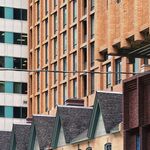Globe: It's Just a Hole in the Ground... (West Donlands)
From the Globe Toronto Section:
It's just a hole in the ground . . . for now
But with a little civil engineering, the West Don Lands will be a place of sylvan beauty
JOHN LORINC
Special to The Globe and Mail
On a sunny morning this week, Julie Beddoes stood on the rooftop terrace of her Distillery District condo and marvelled at what might look, to an untrained eye, like nothing more than a vast, sullen construction site and a massive heap of rubble.
She knows better. Until recently, Ms. Beddoes says she'd often "come up here and peer" at the fascinating scene unfolding just east of the Gooderham and Worts complex, where she has lived since 2000.
After years of planning, the West Don Lands -- a brownfield site that would fit between University and Yonge, and Dundas and Queen -- will begin to take shape this year, the first precinct to be built out as part of the $1.5-billion waterfront revitalization strategy. Construction of a mixed-income housing development with green building design is set to break ground in the fall, followed by a major park next spring.
The Toronto City Summit Alliance conference being held this week will include a progress report on a range of waterfront projects in the West Don Lands, the East Bayfront and the Portlands.
While few Torontonians have tuned into what's going on behind the hoardings near the Distillery District, Ms. Beddoes, a neighbourhood activist, feels the work taking place there is nothing short of historic. "I don't think the city's tried anything on this scale since the R.C. Harris water filtration plant," she says. "I get quite romantic about it."
The development challenges facing the Toronto Waterfront Revitalization Corp. (TWRC) involve contaminated soil, flood protection, aging sewer mains and railway bridges -- all tough civil engineering projects that have had to be sorted out before urban planners can get on with the sexy business of building housing and public spaces. "The level of complexity is staggering," says Cindy Wilkey, a local lawyer who chairs the West Don Lands community liaison group.
The transformation began in earnest last year as excavation crews began digging up old factory foundations, cleaning contaminated soil and crushing concrete rubble, which is to be reused on site rather than hauled away in trucks.
The next step, which begins this spring, is the construction of a four-metre-high berm that is to extend in a shallow arc along the western bank of the Don River and north towards the Queen Street bridge.
Ms. Wilkey says most Torontonians don't realize that the entire financial district sits in the Don River's flood plain, vulnerable to a Hurricane Hazel-magnitude storm. Such a deluge, estimated to occur once every 350 years, could conceivably submerge Bay Street beneath a metre of water and inundate the subway tunnels.
Early in the planning, TWRC officials realized that no development could take place on the West Don Lands until they built a dike-like bank capable of withstanding such a flood. Constructed from the concrete rubble, excavated landfill and a cap of clean soil, this berm will become a major new park. The volume of the soil required -- 300,000 to 400,000 cubic metres -- is equivalent to a 30-storey high-rise.
The immense weight of the mound makes the project formidably difficult.
TWRC engineers discovered ancient riverbeds sitting deep beneath the site, composed of loose, water-locked sedimentary material, says Ralph Davidson, an engineer with CH2M Hill, which is overseeing the berm construction. To ensure the berm doesn't sink over time, the TWRC this spring will begin leaching out that groundwater by piling on heavy fill to compact the soil beneath the berm's base.
Then they'll spend about $2 million to reconstruct a 200-metre stretch of a century-old sewer main that runs beneath the berm's foundation. Mr. Davidson says this repair job is meant to prevent the aging concrete pipe, 1.5 metres in diameter, from being crushed, thereby spewing sewage into the Don.
Meanwhile, construction crews have begun lengthening a CN bridge over the mouth of the Don by adding a span and an extra footing. (If the berm prevents flood waters from washing over the West Don Lands, the river bed must be widened to handle additional flow from a major flood.) That project, now under way, involves routing trains onto one set of tracks while the span is being constructed under the other set.
When the bridge work wraps up this spring, the area beneath it will be excavated and lined with granite boulders before the river is allowed to flow into the enlarged channel.
Once the berm is capped with clean soil later this year, it will be landscaped with native species such as Canadian wild rye, golden rod and black-eyed Susans, says John Wilson, chair of the Bring Back the Don Task Force and a member of the West Don Lands advisory group. But there will be no trees: If a major storm knocks over a tree with a deep root system, TWRC officials say, the resulting hole could lead to a breach in the berm. Mr. Wilson expects planting to begin spring 2008.
The berm's completion also paves the way for the commencement next fall of the TWRC's first housing development -- a 210- to 230-unit Toronto Community Housing Corporation project built at the northeast corner of the West Don Lands, near the junction of Queen and King streets. Ready for occupancy in 2009, it will have a mix of market-priced and affordable apartments and townhouses, with plenty of family-sized units, says Mark Guslits, the housing corporation's chief development officer.
The TWRC began negotiating the deal with the housing corporation as part of a goal to ensure that a fifth of all new housing on waterfront lands will be affordable. It will be designed by Baird Sampson Neuert, an architecture firm that was short-listed this week for the Nathan Phillips Square revitalization competition. Principal Jon Neuert says the complex's eight-storey apartment building will have sustainable green building design features, such as vertical gardens for natural ventilation, energy efficient windows and heat recovery systems.
The low-income families who move in will become the first residents of Toronto's long-term waterfront revitalization campaign -- a point not lost on local activists like Ms. Beddoes. "It's really important symbolically that the first building will be sustainable, affordable and architecturally beautiful."
With these projects now under way, the TWRC and area residents have turned their attention to fine-tuning the more familiar urban design aspects, such as the configuration of a planned streetcar line along Cherry Street, discussed at a design charrette last week.
By stark contrast to the tense planning battles that erupt throughout the city, the residents who've been engaged in the drawn-out and dauntingly technical West Don Lands revitalization have nothing but praise for the way the TWRC is managing the resurrection of the industrial brownfield in their backyards. "It's a bit of a parallel universe," Ms. Wilkey says.
AoD




